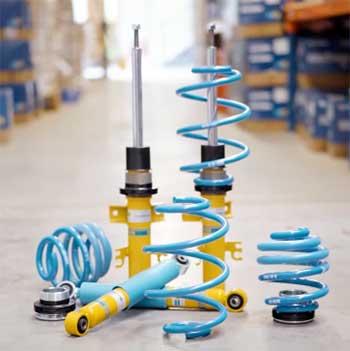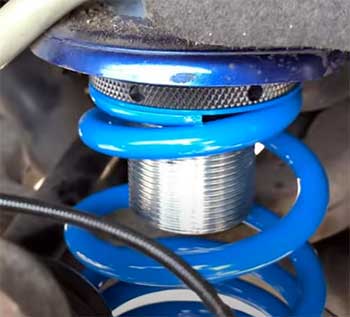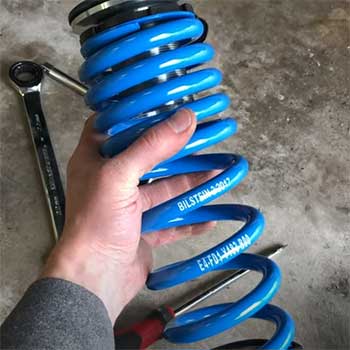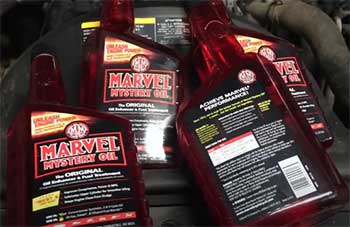I’ve spent countless hours tweaking my car’s suspension, chasing that perfect balance of comfort and performance. When it came to choosing between Bilstein’s B14 and B16 coilovers, I knew I had to weigh every detail to make the right call for my ride.
In this article, I’ll walk you through my experience comparing these two popular coilover systems, breaking down their features, pros, and cons to help you decide which one suits your driving style.
From daily commutes to spirited track days, let’s explore what makes these coilovers tick and how they can transform your car.
A Brief Comparison Table
| Feature | Bilstein B14 | Bilstein B16 |
| Type | Monotube coilover, non-adjustable damping | Monotube coilover, adjustable damping |
| Ride Height Adjustment | 30-50 mm lowering | 30-50 mm lowering |
| Damping Adjustment | Fixed damping rate | 10-stage manual damping adjustment |
| Price Range | ~$1,000-$1,300 | ~$1,800-$2,200 |
| Best For | Daily driving, occasional track use | Track-focused, customizable performance |
| Installation | Straightforward, simpler setup | More complex due to damping adjustments |
| Warranty | Limited lifetime warranty | Limited lifetime warranty |
| Ride Comfort | Smoother, ideal for street | Firmer, tunable for track or street |
| Durability | Zinc-coated, highly durable | Zinc-coated, highly durable |
My Journey With Suspension Upgrades
I’ve always been a bit of a gearhead, obsessed with making my car handle like it’s glued to the road while still being bearable for my daily commute. When I decided to upgrade my suspension, Bilstein’s reputation for quality and performance made their B14 and B16 coilovers the top contenders.
I wanted something that could handle twisty backroads, occasional track days, and still let me cruise to work without rattling my teeth out. After weeks of research, test drives, and chats with fellow enthusiasts, I narrowed it down to these two systems.
Here’s what I learned about how they stack up.
Understanding Bilstein B14 Coilovers
The Bilstein B14 coilovers are like the dependable friend who always shows up ready to roll. Designed for drivers who want a solid upgrade over stock suspension, the B14s are all about balance.
They’re a monotube coilover system, which means they use a single tube filled with gas and oil to handle damping. This design offers better heat dissipation and responsiveness compared to twin-tube systems, making them a favorite for enthusiasts.
Key Features of The Bilstein B14 Coilover

The B14s come with a threaded body that lets you adjust ride height by 30-50 mm, giving you flexibility to lower your car for a sporty stance without sacrificing too much practicality.
The fixed damping rate is tuned for a blend of street comfort and performance, which I found ideal for my daily drives through bumpy city streets.
The zinc-coated body ensures they’re built to last, even in harsh weather conditions.
Installation was a breeze—straightforward enough that I could do it in my garage with a friend over a weekend.
Pros of The Bilstein B14
- Affordability: At around $1,000-$1,300, the B14s are a budget-friendly entry into the world of coilovers, offering premium performance without the premium price tag.
- Ease of Use: With fixed damping, there’s no need to fuss with adjustments. You set the ride height, align the car, and you’re good to go.
- Versatility: These coilovers strike a great balance for daily driving and occasional track use. I could hit the highway without wincing at every pothole.
- Durability: The zinc coating and robust construction mean they hold up well, even after years of use. I’ve had mine for three years with no issues.
- Warranty: Bilstein’s limited lifetime warranty gave me peace of mind, knowing I was covered if anything went wrong.
Cons of The Bilstein B14
- Limited Adjustability: The fixed damping rate means you’re stuck with Bilstein’s tuning. If you want to tweak the ride for specific conditions, you’re out of luck.
- Stiffness on Rough Roads: While smoother than some performance-oriented setups, the B14s can feel jarring on really poor roads, especially if you’re running low tire pressure or aggressive wheel spacers.
- Not Track-Optimized: For serious track enthusiasts, the lack of damping adjustment limits the B14’s ability to fine-tune for lap times or specific track conditions.
I installed the B14s on my 2015 BMW 335i, hoping for a setup that could handle my daily commute and the occasional spirited drive. The result was a car that felt planted in corners, with a lower center of gravity that made turn-ins sharper.
On the street, the ride was firm but not punishing, though I did notice small bumps felt more pronounced than with stock suspension. For the price, I was impressed, but I started wondering if I could get more control for track days.
Exploring The Bilstein B16 Coilovers

Enter the Bilstein B16, the B14’s more sophisticated sibling.
The B16s are for drivers who want to take things up a notch, offering 10-stage manual damping adjustment alongside the same 30-50 mm ride height adjustability.
These coilovers are also monotube, ensuring excellent heat management and responsiveness, but the adjustable damping makes them a game-changer for those who want to dial in their suspension for specific driving scenarios.
Key Features of The Bilstein B16 Coilver
The standout feature of the B16 is its damping adjustability. With a single knob, you can tweak both rebound and compression in parallel, moving from a softer setting for daily driving to a stiffer one for track sessions.
The zinc-coated body and high-quality components match the B14’s durability, but the B16’s construction feels even more premium, designed to withstand the rigors of aggressive driving. The ride height adjustment is identical to the B14, letting you slam your car or keep it practical.
Pros of The Bilstein B16
- Customizable Ride: The 10-stage damping adjustment lets you tailor the suspension to your mood or driving conditions. I could soften it for a road trip or crank it up for a track day.
- Track Performance: The B16s shine on the circuit, offering precise control and the ability to fine-tune for different tracks or driving styles.
- Durability: Like the B14, the B16’s zinc coating and robust build ensure longevity, even under hard use.
- Warranty: The same limited lifetime warranty applies, giving you confidence in the investment.
- Versatility: Whether you’re carving canyons or cruising highways, the B16 adapts to your needs better than the B14.
Cons of The Bilstein B16
- Higher Cost: Priced between $1,800 and $2,200, the B16s are a significant investment, nearly double the cost of the B14s.
- Complex Installation: Adjusting damping settings requires more time and expertise during setup, which can be a hassle if you’re not mechanically inclined.
- Stiffer Default Ride: Even at the softest setting, the B16s can feel firmer than the B14s, which might not suit everyone for daily driving.
- Maintenance: The adjustable dampers require occasional checks to ensure optimal performance, adding a bit of upkeep compared to the B14’s set-it-and-forget-it approach.
I tested the B16s on a friend’s track-prepped Subaru WRX, and the difference was night and day. On the street, I could set the dampers to a softer setting for a decently comfortable ride, though it was still firmer than the B14s.
On the track, cranking up the damping made the car feel like it was on rails—cornering was razor-sharp, and body roll was virtually nonexistent. However, the higher price tag and extra setup time made me question whether I needed that level of adjustability for my mostly street-driven car.
Comparing Ride Quality And Performance

Ride quality is where the B14 and B16 start to diverge.
The B14s are tuned for a balance that leans toward street comfort.
On my daily commute, they absorbed most bumps well, though really rough roads reminded me of their sporty nature.
The fixed damping meant I didn’t have to think about settings, which was a relief for someone who just wants to drive.
The B16s, on the other hand, give you control over ride quality.
At their softest setting, they’re still firmer than the B14s, but not so harsh that you’d dread a long drive. Dial them up, and they transform your car into a track weapon.
I found the B16s excelled when I pushed the WRX through tight corners at an autocross event—the ability to stiffen the suspension made the car feel more responsive and planted.
Performance-wise, both coilovers improve handling over stock suspension, but the B16s take it further. The adjustable damping lets you optimize for specific conditions, like softening for a wet track or stiffening for high-speed stability.
The B14s, while capable, don’t offer that level of precision, making them better suited for enthusiasts who prioritize street driving with occasional performance bursts.
Installation and Maintenance of Bilstein B14 And B16 Coilovers
Installing the B14s was a straightforward affair. With basic tools and some mechanical know-how, I had them on my BMW in about four hours.
The fixed damping meant I only had to worry about setting the ride height and getting an alignment afterward. Maintenance has been minimal—just periodic checks to ensure the threads and components are clean and free of corrosion.
The B16s, however, demand more attention. Installing them took longer due to the damping adjustment setup, and I needed to crawl under the car to tweak the settings initially. It’s not rocket science, but it’s more involved than the B14s.
Maintenance includes checking the damper settings periodically, especially if you’re frequently switching between street and track use. The extra effort is worth it for the performance gains, but it’s something to consider if you prefer a low-maintenance setup.
Cost And Value Proposition
Let’s talk money. The B14s are a steal for what they offer, typically retailing between $1,000 and $1,300. For that price, you get a high-quality coilover system that transforms your car’s handling without breaking the bank.
I felt like I got a lot of bang for my buck, especially since they’ve held up flawlessly for three years.
The B16s, priced at $1,800-$2,200, are a bigger commitment. The added cost comes from the adjustable damping and premium construction, which make sense if you’re serious about track days or want ultimate control over your suspension.
For me, the question was whether the extra $800-$900 was worth it for my driving habits. If you’re mostly street-driving with occasional track outings, the B14s might be the smarter buy. But if you’re chasing lap times or live for spirited drives, the B16s justify their price.
Real-World Driving Scenarios of Bilstein B14 And B16 Coilovers
To give you a clearer picture, let’s break down how these coilovers perform in different scenarios based on my experience and feedback from other enthusiasts.
- Daily Driving
For my 30-minute commute through city streets, the B14s were the sweet spot. They offered a firm but tolerable ride, soaking up most bumps while keeping the car composed in corners. The lower ride height gave my BMW a sleek look without scraping on speed bumps.
The B16s, even at their softest setting, felt a bit stiffer, which wasn’t ideal for long stretches of rough pavement. If comfort is a priority, the B14s win here.
- Spirited Street Driving
On winding backroads, both coilovers shine, but in different ways. The B14s gave my car a planted feel, with minimal body roll and sharp turn-in. However, I noticed some limitations when pushing hard—small bumps could unsettle the car slightly.
The B16s, with their adjustable damping, let me stiffen the suspension for these drives, making the car feel more connected to the road. I could push harder into corners without worrying about losing grip.
- Track Days
Track performance is where the B16s pull ahead. During a track day with my friend’s WRX, the B16s allowed us to dial in the damping for the specific track layout, optimizing grip and stability.
The B14s, while capable for occasional track use, couldn’t match that level of precision. If you’re hitting the track more than a few times a year, the B16s are the better investment.
My Decision-Making Process

Choosing between the B14 and B16 came down to my driving habits and budget.
I love spirited drives on weekends, but my car is primarily a daily driver.
The B14s gave me the performance boost I wanted without the complexity or cost of the B16s.
However, after experiencing the B16s on the track, I started to see their appeal for someone who spends more time pushing their car to its limits.
I also considered other brands like KW and BC Racing, but Bilstein’s reputation for durability and their lifetime warranty kept me loyal.
The B14s were the practical choice for me, but I’d be lying if I said I didn’t daydream about the B16’s adjustability on particularly twisty days.
Community Feedback and Insights
To round out my research, I scoured forums and talked to other enthusiasts. On platforms like Bimmerpost and Reddit, B14 owners praised their balance of performance and comfort but noted they can feel harsh on poorly maintained roads.
One user mentioned their B14s felt “jarring” on small bumps, suggesting a slight ride height adjustment to avoid riding on bump stops. B16 owners, meanwhile, raved about the ability to fine-tune for track days but admitted the stiffer ride wasn’t always family-friendly.
Some users compared the B14s to KW V2s or BC Racing coilovers, noting that Bilstein’s damping is often firmer, prioritizing performance over plushness.
Others highlighted the B16’s superior track performance but cautioned about the higher cost and setup complexity. This feedback reinforced my findings: the B14s are a solid all-rounder, while the B16s are for those who want to push their car harder.
Also Read: Comparison of FCS And Monroe Struts.
Frequently Asked Questions (FAQ)
The B14 has fixed damping for a balance of street comfort and performance, while the B16 offers 10-stage adjustable damping for customizable ride quality, ideal for track use.
With proper maintenance, B14 coilovers can last over 5-7 years or 100,000+ miles, thanks to their zinc-coated, durable construction.
Yellow Bilstein shocks (like B6/B8) are performance-oriented with a sportier feel, while black shocks (like B4) are designed for OEM-like comfort and longevity.
The B4 is Bilstein’s OEM replacement shock, designed for stock-like ride quality with improved durability over factory shocks.
Making The Right Choice For You
You’re probably wondering which coilover is right for your car, and honestly, it depends on what you value most. If you’re like me—a driver who wants a sporty upgrade for daily driving with occasional fun on twisty roads—the Bilstein B14 offers incredible value and performance without overwhelming you with adjustments.
Its affordability, ease of use, and durability make it a no-brainer for most enthusiasts. But if you’re chasing lap times, love tweaking your setup, or want the ultimate in control, the B16’s adjustable damping and track-ready performance are worth the extra cost.
Take a moment to think about your driving habits. Do you spend more time on the street or the track? Is budget a concern, or are you willing to invest for maximum versatility?
Whichever you choose, both the B14 and B16 will elevate your driving experience, transforming your car into something that feels alive and connected to the road. I went with the B14s and haven’t looked back, but I’d love to hear what you decide—your perfect setup is out there waiting.

